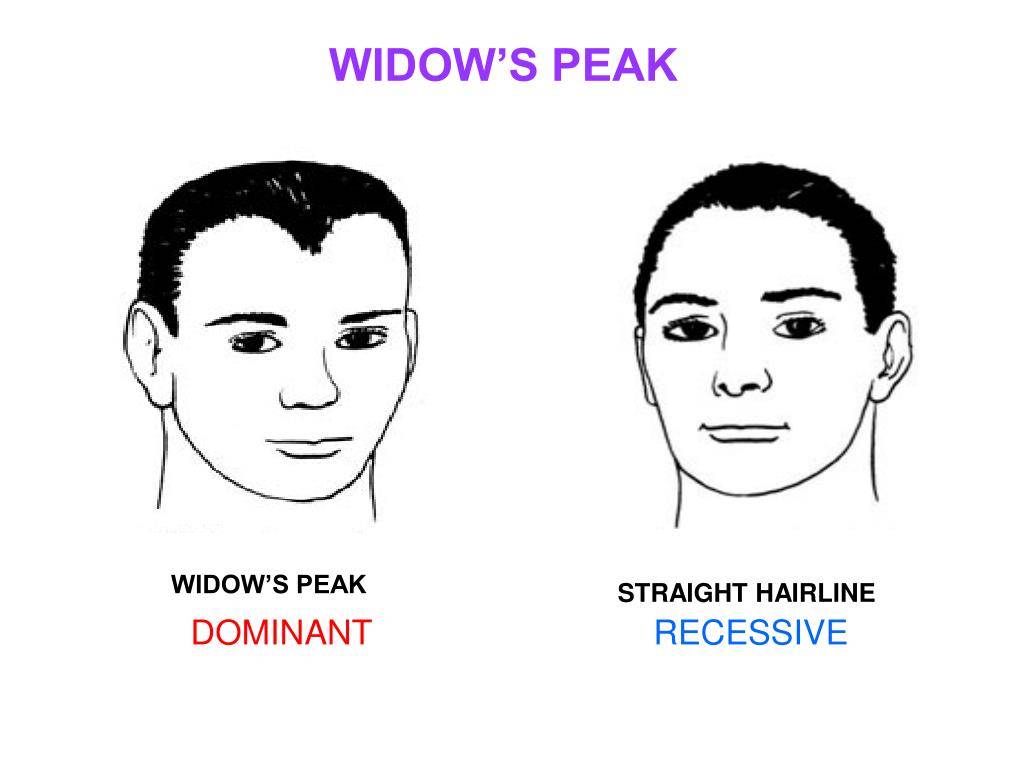What Is a Widow’s Peak?
There are two types of hairlines called widow’s peaks. The first is a V-shaped section of hair in the center of the forehead that is part of the normal hairline. This appears before the hairline begins to mature and is not associated with hair loss. This can present as a small, distinct point on the hairline. However, some people have subtler widow’s peaks.
The second type of widow’s peak is a similar shape caused by hair loss. It appears when the hair over the temples and along the hairline starts to recede. This makes the hairline create more of a V-shape.
Typically, the latter type of widow’s peak is not as distinct or pointed as the former. However, in some cases, a sharp point can appear due to hair loss (the hairline does not recede completely evenly).
What Causes Widow’s Peak Hairlines?
As mentioned, traditional widow’s peaks are a completely natural type of hairline. They are believed to be linked to some genetic components because they appear to her inherited. However, the exact cause is not known.
The good news is that it is not something you need to worry about at all. It is simply part of your hairline. If you find a good hairstyle for you, then you’ve done everything you need to for your widow’s peak.
The type of widow’s peak related to hair loss can be the result of androgenetic alopecia (male pattern balding) or a maturing hairline. It is less common for women to experience widow’s peaks from hair loss because female pattern balding is typically a consistent thinning all over the scalp.
Maturing hairlines are a normal form of hair loss that affects a lot of men. If you have experienced this, it does not mean that you will have any more hair loss. For many men, the hairline recedes by up to 15 millimeters, but stops receding by the early 30s. In some cases, this can cause a slight V-shape.
More substantial widow’s peaks are the result of balding. This happens because the temples and crown are the most susceptible parts of the scalp to dihydrotestosterone, the main hormone involved in male pattern baldness. Excess DHT in these areas causes the hair follicles to shrink. They then produce increasingly small hairs until the hair in the area no longer breaks through the skin.
What Can You Do About Your Widow’s Peak Hair Loss?
Hair loss of any kind can be upsetting to have to deal with. If you are experiencing a widow’s peak, that may be an early indicator of future balding. Fortunately, you don’t have to settle for hair loss.
As mentioned above, this is often caused by androgenetic alopecia. The main androgen (male sex hormone) that affects this is called dihydrotestosterone. Blocking DHT is a common strategy for mitigating hair loss. This may help some hair to regrow. However, blocking DHT is more focused on preventing further growth.
To help stimulate new growth, many substances can be helpful. Balding causes two key issues with hair follicles: a longer telogen (resting) phase and smaller follicles. The result is shorter, weaker hair. By addressing these issues, you can again enjoy healthy, growing hair.
Some treatments focus on opening up the blood vessels in the scalp to bring nutrients and oxygen to the follicles. These help them grow larger again, thus producing thicker and stronger hair strands. Other treatments improve the length of the anagen (growth) phase. This means that each hair strand will grow longer.
What Products Can Help With Hair Loss?
DS Laboratories applies multiple clinically tested ingredients in each of our treatments. Using a combination approach allows us to tackle hair loss more effectively. If you are experiencing a widow’s peak from a receding hairline, these products may help:
-
Revita Shampoo: This shampoo is designed to block DHT and stimulate new hair growth when used five times per week. It includes powerful ingredients such as tri-copper peptides, biotin, ketoconazole and procyanidin B2. Studies indicate that 92% of users experience a decrease in hair loss.
-
Revita Conditioner: This product is intended to be used with the shampoo. It also includes powerful hair growth and health ingredients such as cysteine, zinc gluconate, copper peptides and caffeine. When used with the shampoo, a large majority of users notice an improvement in the overall appearance of the hair.
- SPECTRAL.DNC-N: This powerful topical treatment includes nanoxidil, an innovative vasodilator that opens ion channels in the scalp. It has been shown in studies to increase hair growth. Other proven ingredients in this treatment include adenosine, tri-copper peptides, caffeine and azelaic acid.
All three products include ingredients with hair growth benefits backed by science. At DS Laboratories, we only use the best ingredients in our products.
Explore the DS Laboratories Catalog
Check out all of the DS Laboratories’ catalog of hair health products. We have a diverse selection of clinically tested products to help with numerous hair problems. Whether you have hair loss or just want stronger, healthier hair, we have something for you. Take our hair assessment to find the right products for your needs.
You don’t have to settle for a receding hairline or widow’s peak. Try DS Laboratories’ products today and see how much improvement you can achieve.

